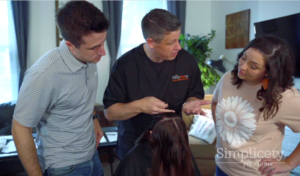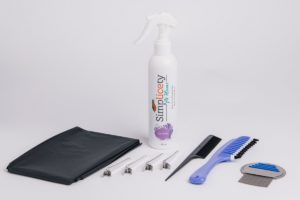“Let’s take a selfie!” That statement is ingrained in our culture, but it may also be the phrase that increases the chances of lice being ingrained in your child’s head.
Why? When children take a selfie, play a smartphone game together or huddle closely to watch the latest TikTok, they have head-to-head contact. Contrary to popular belief, lice do not have the ability to jump, fly or hop – they crawl from one head to another with direct contact.
When a child places their head close to another child’s head infected with lice, they unintentionally welcome lice to take a quick, easy ride to their hair. As a matter of fact, it only takes three seconds of contact for lice to spread from one person to another.
Although boys and girls can both get head lice, girls are more likely to contract lice due to the fact that they tend to have longer hair, which creates a bridge for the lice to transition easily. It also doesn’t help that girls tend to be huggers, selfie-takers, and in closer contact more often than boys.
Avoiding Lice

Pete, the owner of Simplicety and Simplicety At Home showing parents how to properly check for head lice.
Another myth is that lice is the result of a dirty home or dirty hair. We all remember neighbors closing down homes to scrub. Heck, I had a family call and by the time I arrived, they had a cleaning crew at their house. Good news: YOU DO NOT have to do that! These pesky little creatures will not survive after 24-48 hours of being off someone’s head and they are harmless once they are off of a human head for more than 12 hours.
The key to avoiding lice is to avoid head-to-head contact. Knowing that is not always possible with our daily habits, parents should regularly check their children’s hair. For most the first sign is a child itching their head. Although it is important to note that some children’s heads will not itch, so do not wait for this as the first sign of lice. Parents should also teach their children about the importance of personal space and decreasing head-to-head contact as much as possible. Education is the key to helping to reduce the spread of this invasive parasite.
In 2019, The CDC estimated 6-12 million people became infested in the United States.
To avoid being part of that statistic, simply check your child’s hair. The most effective way to do so is with a tight metal lice/nit comb. When checking the head simply apply pressure to the scalp with the teeth of the comb. With pressure applied, run a comb in all the hot spots for lice (around and behind the ears, along the hairline of the neck with extra focus on the nape of neck and then also at the crown of the head. Then you will want to wipe on a white paper towel. The reason being is nits and lice are dark in color so when you wipe on a white paper towel you will be able to see them right away. If it turns out to be dry skin or dandruff then that would blend right into the paper towel.
Treating Lice
One common mistake that leads to re-occurrences is using off-the-shelf, toxic chemicals to kill the lice on the child’s head. This isn’t effective long-term because it often doesn’t eliminate all the lice and can be dangerous, especially to younger children. The trick is properly removing the head lice and nits. If you use the proper technique, you can easily remove all the lice and nits in even the worst cases. With a few simple tools and some professional instructions, you can get rid of lice yourself at home, without toxic chemicals. 
While we all remember school nurses yanking hair, there’s a better way with at-home kits that can be stocked and at the ready, just like any other preparation for your child’s medical needs. One example is the at-home kit and other treatment information that is available at SimplicetyAtHome.com.
Selfies with Space
Almost all kids will contract head lice at some point, so knowing how to prevent and treat it is key. And remember, it’s not because your home or child is dirty. No guilt trips needed for your or your child!
So next time your kids are huddled around a smartphone together, remind them to leave some space. The best way to avoid head lice is to avoid children’s heads touching,even when they’re trying to capture the perfect selfie.


